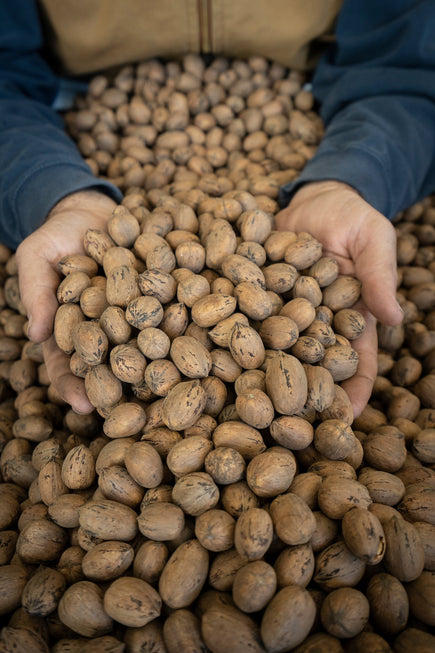
ECONOMICS OF PECAN GROWING
ROBERT H. KENSING
Area Farm Management Specialist
Texas Agricultural Extension Service
San Angelo, Texas
THE ECONOMICS of pecan growing involves many things. In fact, it is safe to say that every practice involved in the production of pecans for profit requires the application of some or all the economic principles---knowingly or unknowingly.
In most cases, management decisions regarding the advisability of doing certain things in certain ways---and when to do them will be governed by which practice returns the most net income for the amount or resources invested. When profit is the primary goal of the pecan grower, he must make many correct decisions---and practically none that are incorrect.
There are a vast number of important points any pecan grower must consider. Some are more important than others---but no point is unimportant. When this fact is accepted in the beginning of the planning stage, the chances for financial success are enhanced a great deal. This simply means from the farm management viewpoint that a pecan grower must arm himself with as much information as he can---before he makes decisions.
Managing a pecan grove for making or increasing net returns may go some-think like this; (1) determining objectives and goals; (2) inventorying resources; (3) making decisions and taking actions; and (4) evaluating and making adjustments. These broad general categories form the framework for the specific steps required to make money from pecan production. Each category probably is equally important.
Determining Objectives And Goals
The owner or manager of resources suitable for pecan production must first decide what he wants. If his objective is making more profit from pecans, he will be concerned with the economics of this decision---and every other future decision.
There can be a big difference between objectives that may appear to be similar. For example, a goal of producing the maximum pounds of pecans per tree or per acre, and the goal of making the greatest net return from the resources available may not be the same. At any rate, economists do not see them as being the same, because maximum production is not necessarily the most profitable level---although it may be in some instances. Management must be concerned with production, but the costs of production are equally important.
So the first management step for a pecan grower is to counsel with himself regarding his objective or goals.
Inventory Resources
Each owner or manager of pecan land has certain resources that will enhance or limit his chances for financial success as a pecan grower. It is tremendously important that these assets and liabilities be identified and inventoried to lay the foundation for a sound management program.
The inventory involves such things as number of trees, condition of trees, soil, water, past history and other factors. It is as important to a manager to know precisely what he has to work with as it is for him to know what he wants to accomplish.
Many resources are limited. These limitations must be recognized and must be taken into account when planning. To do otherwise is an invitation to financial failure.
The basic resources of land, labor, capital and management must be present in sufficient quantities of adequate quality---or the venture will be in trouble from the very beginning. In other words, it is just as sad to be “a dollar short and an hour late” in a pecan enterprise as in any other.
Making Decisions And Taking Actions
The third phase of this sample management program is all-important primarily because by this time a number of resources may have been committed. Each practice involved in developing or maintaining a pecan enterprise should be performed according to a program outline d by some logical system. From the standpoint of economics, the order in which practices should be done would be determined largely by the rate of return from each practice. Those paying the most would be done first---and so on down the line.
Although there are exceptions to the following order, it is an example of one possible management plan.
1. Clearing and cleaning up---general sanitation.
2. Identification of trees and production records.
3. Disease and insect control.
4. Nutrition and irrigation.
5. Harvesting.
6. Top-working for variety change or beautification.
Clearing And Cleaning Up
Assuming a grove of native timber that is in a totally "wild" state, there is no question about the first practice. A dollar spent or invested in cleaning out underbrush and foreign timber will return more potential net returns than any other immediate expenditure. A pecan grove must be clean to produce at maximum efficiency, and it must be clean for more economical harvesting.
There are a number of alternative methods for clearing and cleaning a grove. These range from a hand axe to a chain saw to a bulldozer. Each method has a cost that must be determined. If operating capital is not limited---heavy machinery may be the best method even though the cost may range $10 to $60 or more per acre. The cost will be influenced by many factors, but machine clearing saves time and may speed up production.
However, if operating capital is limited compared to labor, it may be less costly to use saws and axes. The point here is that each individual operator must base his decision for selecting a certain method with his own resources in mind. This requires the application of economic principles whether he realizes it or not.
One additional point regarding cleaning up pecan land. The thoroughness with which it is done will have a great deal of influence on the degree of success of practically every subsequent practice applied.
Identification---Records
Identification of trees and production records require minimum expenditures of resources---thus assuring the operator a high rate of return per dollar spent. The cost should not exceed 50 cents per tree plus a few dollars for paper and pencils.
Most pecan groves include trees that bear lighter crops than others. Such trees may be removed over a period of years---preferably on the basis of identification and records. It is doubtful that any other practice will give a higher return per unit of input. Therefore it is high on the economic list.
Disease---Insect Control
The next step is disease and insect control. It is reasonable to state that healthy trees are more profitable than unhealthy or unthrifty ones. Therefore it seems logical to assume that health care is the next practice to use to maximize returns per unit of input.
It is also reasonable to consider that the only safe estimate of the cost of disease and insect control is that it varies from very little to a lot---depending on the area, year, size of grove and other factors.
When rating the potential economic return to measures for the maintenance of healthy trees, it appears that disease control rates higher than insect control simply because insect infestations sometimes come and go, while a diseased tree usually stays diseased from year to year until something is done. This means that resources used for disease control normally pay better returns per dollar spent compared to insect control.
Disease and insect control measures require the operator to make decisions regarding ownership of equipment versus hired custom spraying. Also, the size of equipment, materials used, as well as the time of application, all affects net returns.
Nutrition---Irrigation
A somewhat valid argument could be made for listing nutrition and irrigation ahead of disease and insect control as a higher paying practice. Basically, abundant food and water go a long way toward maintaining the health of trees. How to rate these practices as far as economic returns are concerned will be governed by circumstances in individual cases. If lack of plant food is indicated to be the cause of unsatisfactory production, the application of fertilizer is in order. This, however, brings up the questions of what kind, how much and when to apply---to list a few.
The important point to consider here is not only the cost---but the return per dollar invested or spent. To more accurately make decisions regarding fertilizer and irrigation, the grower needs records of past performance. This only serves to call attention to the need for doing step two---identification and records---before considering step four---fertilization and irrigation.
Harvesting
A number of alternative methods for harvesting pecans can be considered. One economic principle involved here is keeping the cost as low as possible---provided each method is equally acceptable.
The decisions to harvest with machinery, to sell the crop on the trees, to harvest on shares, to hire a complete service---logically are based largely on the original inventory of resources and should have been taken into account when the initial objectives were established.
For the operator with abundant resources of capital, harvesting with his own machinery is entirely possible. For the operator with limited resources, owning expensive harvesting equipment is pretty much out of the question.
By and large, harvesting costs make up such a large portion of the total cost of production per pound of nuts harvested that a pecan grower must give high priority to this phase of his operation.
Topworking
Pecan growers are becoming more conscious of the importance of varieties, largely brought about by market demands. If the demand for higher quality shelling pecans continues to grow, many growers will be faced with the problem of changing varieties.
Topworking trees can mean considerable out-of-pocket costs unless the operator can do the work himself. This method, of course, is not feasible for large groves. Therefore, a large number of economic decisions are required to select the varieties, the trees to topwork and the method for doing the work.
Beautification is a term used here to identify the practice of planting trees in open spaces---or removing unnecessary trees---not only to add beauty to the grove, but also to gain better utilization of the land resource by getting more production for each acre of land, thus lowering average fixed costs for the grove to some extent.
An additional point that merits mention is the indirect long-term economic advantage of developing a pecan grove as a long-range capital investment---even if no net profit is ever realized from the sale of pecans. The appreciation in the value of the land will be---in most instances---more than enough to justify investing the resources. However, this is only true if the need for current income does not limit this alternative practice.
Evaluations and Adjustments
No management program can be a good one without constant evaluation and adjustment. There can be no better method of evaluation than close observation plus accurate measurement of production. When adjustments are indicated, they should be made on the basis of which ones will give the highest return per dollar spent.
No implication should be made from the foregoing remarks that the example management program is complete or that each practice should be carried out separately. There must be overlapping of the various practices because the benefits from each are complimentary.
To make the greatest net return per dollar invested, some attention should be given to the order suggested---or to a similar program.
Of course, the backbone of any operation is the accounting or records system. The information contained in a good set of records is absolutely necessary for making good management decisions. Proper analysis of the records for the pecan enterprise can point out the most logical steps to take to maximize net returns.
Management is the key to success.

